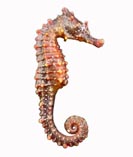| Family: |
Syngnathidae (Pipefishes and seahorses), subfamily: Syngnathinae |
| Max. size: |
15 cm TL (male/unsexed) |
| Environment: |
demersal; marine; depth range 0 - 15 m, non-migratory |
| Distribution: |
Indo-Pacific: endemic to south west Australia. |
| Diagnosis: |
Dorsal spines (total): 0-0; Dorsal soft rays (total): 19-23; Anal spines: 0-0; Anal soft rays: 4-4. Description: (based on 40 specimens): Adult height: 4.5-8.0 cm. Rings: 11 + 40 (39-43). Snout length: 3.0 (2.4-3.5). Dorsal fin rays: 20-21 (19-23) covering 3+1 rings. Pectoral fin rays: 14-15 (13-15). Coronet: tall, columnar or knob-like. Spines: irregularly developed, some very low, others very prominent rounded tubercles. Other distinctive characters: with or without mane of thick skin fronds on the head and neck region; mature males have prominent brood pouch.
Color pattern: purplish brown or yellowish or reddish; numerous dark-margined ocelli (white spots); often with dark spots or patches, especially on head; ventral surface of tail with paler transverse stripes. |
| Biology: |
Adults inhabit inshore waters (Ref. 7300). Occur in small to large aggregations in weed patches attached to rocks on sand, mostly in Sargassum weeds (Ref. 9002). Ovoviviparous (Ref. 205). The male carries the eggs in a brood pouch which is found under the tail (Ref. 205). Minimum depth reported taken from Ref. 128812. |
| IUCN Red List Status: |
Least Concern (LC); Date assessed: 23 August 2016 Ref. (130435)
|
| Threat to humans: |
harmless |
Source and more info: www.fishbase.org. For personal, classroom, and other internal use only. Not for publication.

